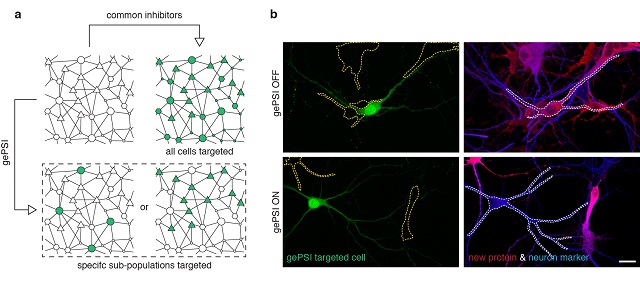News Archive
Proteins are needed for memory, but where and when?
July 2019. Long-lasting memories in the brain are made possible by remodeling the connections (“synapses”) between brain cells, or “neurons”. During memory formation, the complement of proteins present at synapses is remodeled by making new proteins and degrading old ones, leading to a change in how the synapse functions - a physical impression of the memory. Studies in the 1960s performed with rats showed that injections of drugs that block protein production (protein synthesis inhibitors) during or just after learning block subsequent memory for the learned task. These early studies have been replicated over the past 50 years many times. From these experiments, we know that protein synthesis is required for memory formation, but because the chemical inhibitors block protein synthesis in all cells, it is not known which cells are important and when they need new proteins. To solve this problem, Heumueller and colleagues have borrowed a tool from plants. Many plant species have genes that encode proteins that are potent inhibitors of protein synthesis- they use these inhibitors to ward off predators. In the upcoming online issue of Nature Methods, an international team of scientists led by Erin Schuman, director at the Max Planck Institute for Brain Research, modified the plant protein so that it’s expression can be controlled: researchers can turn on and off the protein synthesis inhibitor in the right cells at the right time. The team calls their modified protein gePSI- for genetically encodable protein synthesis inhibitor. The gePSI can be used to study which cells are important for learning and memory but also might be useful in very different situations. For example, it could be used to block protein synthesis in cancer cells. More...
The figure shows the genetically encodable protein synthesis inhibitor (gePSI). (a) All tissues are composed of different cell types that interact with one another. In the scheme shown there are 4 different cell types (depicted as triangles, hexagons, small circles and big circles). Regular chemical protein synthesis inhibitors (“common inhibitors”) are very potent and exert their inhibitory effect on all cells they come in contact with (shown as filled green shapes), making specific targeting of inhibition almost impossible. The genetically encodable protein synthesis inhibitor (gePSI) can precisely target discrete cell-types even in very dense and heterogeneous tissue, for example the large circular cells or the triangular cells. (b) Representative pictures of gePSI targeted neurons grown in a hippocampal culture are shown in green, the neighboring untargeted cells are shown with dashed-yellow outlines. In the top 2 panels, the gePSI has not been turned on (gePSI off), in the bottom set of images it has been turned on (gePSI on). In the right panels, the level of protein synthesis in individual cells (same cells as shown in the left panels) is shown by the red signal. In the “on” gePSI-targeted cell (outlined in white), the protein synthesis is abolished, whereas the neighboring (non-gePSI targeted cells) there is substantial protein synthesis. The blue color indicates a marker protein for neurons (Scale bar, 20 μm; Max Planck Institute of Biophysics)
Contact:
Erin Schuman, Max Planck Institute of Brain Research, Frankfurt, Main, erin.schuman@brain.mpg.de
Publication:
Maximilian Heumüller, Caspar Glock, Vidhya Rangaraju, Anne Biever & Erin M. Schuman (2019): A genetically encodable cell-type-specific protein synthesis inhibitor. Nature Methods, published online 15 June 2019, doi 10.1038/s41592-019-0468-x (Link)
This study was supported by the Max Planck Society and the European Research Council.


